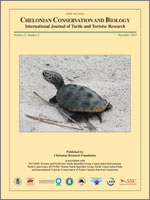Sea turtle bycatch in commercial fisheries is a serious global problem. An estimated 250,000 loggerhead (Caretta caretta) and leatherback (Dermochelys coriacea) sea turtles are taken each year as incidental catch by the pelagic longline fishing industry. Studies have examined various deterrents for their potential to repel sea turtles from the vicinity of fishing operations; visual deterrents such as shark models/silhouettes and gillnet illumination have shown the most promise. However, given the difficulty of directly observing sea turtle behavior in the wild, laboratory trials are crucial for characterizing the sea turtle response to shark models. The present study examined the response of 42 captive-reared juvenile loggerhead sea turtles to a shark model in a controlled laboratory setting. Loggerheads exhibited defensive behavior toward the shark model, taking significantly more time to bite squid bait beneath the shark model than that for squid beneath a control object (sphere) and bare squid. Also, the turtles approached the shark model less often and exhibited more defensive carapace turns toward the shark model. Although the shark model in this study elicited avoidance behavior in loggerhead sea turtles, further research is needed to identify plausible applications, which would reduce sea turtle bycatch while maintaining target fish catch rates. It may be possible to develop a “Children's Day Koinobori kite” (a three-dimensional kite) in the shape of a shark that would unfurl and “fly” underwater and could possibly clip to main or float lines in commercial fisheries.
How to translate text using browser tools
1 December 2014
Novel Use of a Shark Model to Elicit Innate Behavioral Responses in Sea Turtles: Application to Bycatch Reduction in Commercial Fisheries
Angela Bostwick,
Benjamin M. Higgins,
André M. Landry,
Marti L McCracken
ACCESS THE FULL ARTICLE
bycatch reduction
fishery interaction
gear modification
predator avoidance
Reptilia
sea turtle
Testudines





